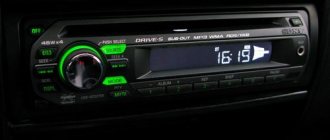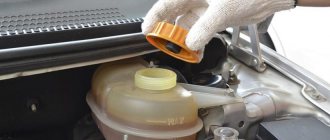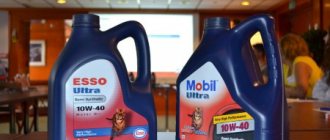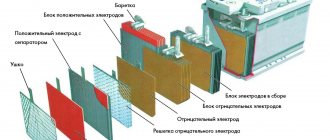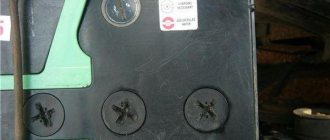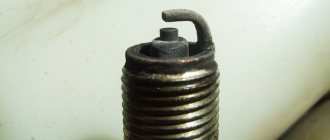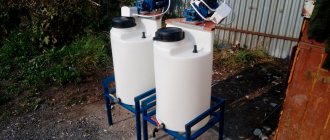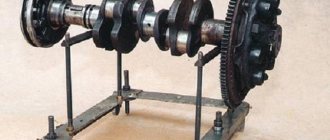01/05/2021 9 318 Dashboard
Author: Ivan Baranov
A pressure gauge is a device whose purpose is to measure pressure levels. And the need to measure a motorist’s pressure may arise in different cases. You can find out more about how car pressure gauges are checked at home and what requirements apply to these devices below.
[Hide]
Accuracy of pressure gauge readings: don’t trust - check
A pressure gauge is a device whose purpose is to measure pressure levels. And the need to measure a motorist’s pressure may arise in different cases. You can find out more about how car pressure gauges are checked at home and what requirements apply to these devices below.
First, let's look at the requirements for pressure gauges according to GOST:
- Installation of the device in accordance with GOST can be carried out on the vessel fitting up to the shut-off valves.
- The main requirement according to GOST, which must be presented, concerns such a nuance as the error of the pressure gauge. The accuracy class must be at least 2.5 if the operating pressure level is below 25 kg/cm2. If the pressure is higher, then the accuracy class should be equal to 1.5.
- Any device according to GOST is equipped with a scale so that the measurement limit of the required parameter is located in the second third of the scale.
These are the basic requirements that apply to devices of this type in accordance with GOST.
Pressure sensor on Daewoo compressor
Calibration Features
Next, we invite you to learn about calibrating the device.
The device calibration procedure itself can generally be divided into several main steps:
- Diagnostics of parameters, which we will discuss below, using a known standard or input data.
- The next step will be to adjust the device until the obtained indicators become equal or proportional in accordance with the existing input data.
As for calibration itself, this procedure includes many checks and adjustments. When the device is fully calibrated, this will mean that it will be able to obtain the most accurate values of the parameters that you measure.
Now let's briefly talk about the equipment that may be needed for calibration. The basic equipment that will be required should include a so-called reference device, a source of operating pressure that can be adjusted as needed. You will also need elements to connect the device to a pressure source and a reference device and several tools that will be useful for adjusting the device. The purpose of measuring devices is to transfer the sizes of physical units from standards to working devices.
Photo 1. AM for measuring pressure Photo 2. Measuring tire pressure
As for working measuring instruments (measuring devices), their purpose is to carry out measurements in industry. According to their accuracy class, they can be divided into technical and laboratory. Since not every car enthusiast has such devices, taking measurements can be problematic.
All about verification
Now let's talk about how pressure gauges are checked, the timing and frequency of the devices being checked, and what rules should be followed.
If calibration of pressure gauges is carried out in laboratory conditions, then according to the rules it includes the following steps:
- visual diagnostics;
- setting the scale needle to the zero mark;
- diagnostics of the position of the arrow on this mark;
- The verification methodology includes identifying the main error.
Frequency and timing
As for frequency, at enterprises it is usually entered into the appropriate audit log. But since ordinary car enthusiasts usually do not keep a log of control checks of pressure gauges, this information can be recorded separately in a notebook. The frequency of diagnostics may vary depending on the device manufacturer; according to the rules, on average it can range from 12 to 60 months (the author of the video is the Avtozvuk.ua channel - Avtozvuk Database).
Instructions for checking the pressure gauge yourself
Now briefly about how to check the pressure gauge yourself. Before starting measurements, it is necessary to carry out a visual diagnosis of the device. Carefully inspect the case for cracks, chips, gaps or other mechanical damage that could lead to the device not working. If you notice traces of damage, and the device basically does not work, then further diagnostics will most likely be useless. It will be much easier to buy a new device than to waste time and resources on repairing the old one.
As for directly diagnosing values, it is carried out as follows:
- First you need to diagnose the pressure, but for such a check you will need a so-called reference device, that is, a device whose readings you are confident in. If you are measuring compression in the cylinders of a power unit or, for example, in car tires, then measure the pressure first with one device and then with another. If the readings of your device do not coincide with the reference one, you need to adjust it. You need to ensure that the readings from the measurements using the two devices match.
- To make adjustments, special adjustment screws must be located on the device body. If you are using an electronic device, then the principle here is generally similar, but it should be taken into account that devices of this type have inertia. Accordingly, the readings will need to be held from 8 to 10 s.
- If you do not have a reference device, you can diagnose the correctness of the readings using calculations. You will need a vessel whose volume you know exactly, and the air in it is at atmospheric pressure, the level of which is measured by a barometer, and the temperature should be room temperature. The vessel should be tightly closed and heated slightly to increase the temperature and pressure, which should also be measured. You should calculate the pressure reading in the vessel itself by dividing the final heating temperature with the initial room temperature. After this, the result should be multiplied by the atmospheric pressure.
- If the device’s performance at this temperature does not coincide with those that were calculated, it is necessary to adjust the device so that the device shows the value that was obtained during the calculations. When you make calculations, take into account the fact that the temperature level should be measured in Kelvin, and for this, the number 273 should be added to the resulting degrees Celsius. In most cases, the scales on devices are graduated in kg/cm2, accordingly, the calculation will be carried out in pascals or mmHg. Therefore, to obtain more accurate results, it will be necessary to convert all units and only after these steps make comparisons.
If the adjustment does not give the required results and the readings obtained from the device are not correct, you can try to have the device diagnosed by specialists. But if even in laboratory conditions it was not possible to obtain the desired result, then the only way out is to repair the device or replace it.
Video “Review of digital Chinese car pressure gauge”
In the video below you can see a review of a digital car device brought from China (the author of the review is Andrey Kanaev).
Was this article helpful?This article was helpfulPlease share the information with your friends
Methodology for checking pressure gauges
To check the operation of the measuring device, you should contact specialists who have received accreditation of a sufficient level (in accordance with the type of pressure gauge you have); these organizations are registered in the state register. The service must be provided by trained employees. Verification is also carried out by state metrological control bodies. You will then be provided with a protocol, which should be kept until your next follow-up visit.
The pressure gauge can be checked in several ways using:
- metrological stand;
- hydraulic press;
- calibrator.
Checking the pressure gauge using a metrological stand allows you to check the pressure at the installed control points with minimal error. The process is carried out using two pressure standards and comparing their indicators. The device creates special pressure using a pump. Deadweight piston devices are used more often.
Verification using a hydraulic press takes place on a device that includes several weights, a standard meter and a device that sets the pressure, a press. A calibrated pressure gauge is installed between the parts of the apparatus. The final data of the pressure gauge under study must coincide at the control points of the scale. These devices are highly accurate and allow a minimum error (0.04 psi).
The first two methods of verifying measuring instruments are provided for when sealing and installing a stamp on the device being verified and require clear, normatively recorded actions on the part of the service provider (issuance of a protocol or certificate of work performed).
Verification using a calibrator does not apply to measuring instruments that require control and supervision by the state. This device is mobile, it allows you to conduct research at the location of the device.
How to check the pressure gauge
Instructions
The pressure gauge should, as a rule, be installed in such a way that its readings are clearly visible to operating personnel. The nominal diameter of the housing of pressure gauges, which are installed at a height of up to two meters from the level of the observation platform, should be approximately 100 mm, no less. At a height of two to three meters - no less than 160 mm. In this case, it is prohibited to install the pressure gauge at a height of more than three meters from the level of the observation platform. A special three-way valve or a replacement device must be installed between the pressure gauge and the vessel, which will allow periodic checking of the pressure gauge using a control device.
If necessary, especially depending on the operating conditions, as well as the properties of the working environment, equip the pressure gauge with a siphon tube, an oil device, a buffer and other additional elements that can ensure reliable operation of the pressure gauge and protect it from direct exposure to the environment and temperature.
Pressure gauges and pipelines connecting them to the vessel must be well protected from freezing.
Next, connect the monometer itself. Tighten it on the tee, slightly short of the pressure gauge itself, to expel the air.
Pressure gauges cannot be approved for use in such cases when: there is no seal or stamp with a mark indicating that the necessary verification has been carried out, the period for this verification has expired, and also if the pressure gauge needle does not return to the zero scale value when it is turned off, and if the glass of the pressure gauge is broken or there are any -even minor damage that may affect the accuracy of the readings. If a malfunction is detected, the pressure gauge must be sent for repair. Before submitting for repair, clean the pressure gauge from dirt and rust.
Why is verification needed?
There are specialized companies that provide services for checking pressure gauges for accuracy.
The pressure gauge measures:
- excess water pressure;
- gas;
- oxygen.
If incorrect operation of the device is detected, it is necessary to check it. The purpose of checking a pressure gauge is to detect an error and correct it.
Cure for pressure: testing tire pressure gauges
March 6, 2014
The better cars become, the less attention their owners pay to them. We have become so lazy that we don’t pump up our tires for years and don’t even remember about the pressure in them. Probably, many people hope: if something happens, the “check engine” light will light up on the panel (in common parlance - “Jackie Chan”), and then technical assistance will arrive to pump up the tire. Meanwhile, any tire guru will reliably list what suffers from incorrect pressure: fuel consumption, handling, braking distance, comfort, tire mileage, suspension life.
It is gratifying that tire pressure gauges have not disappeared from sale. Some people want to buy for their appearance alone. It remains to be seen whether they are useful. It is a pity that many are not equipped to relieve excess pressure. Previously, the valve caps were made of steel, with a short screwdriver; it was not difficult to unscrew the spool and relieve the pressure. Modern caps are plastic, pinless - what to do if you overinflated them?
We tested samples from different classes - mechanical and electronic, simple and elite. In the photo they are arranged in alphabetical order. We liked two of them more than others: they combine absolute accuracy with ease of use.
Check your blood pressure often, colleagues! And not only arterial...
Cure for pressure: testing tire pressure gauges Cure for pressure: testing tire pressure gauges Error in the text? Select it with your mouse! And press: Ctrl + Enter
